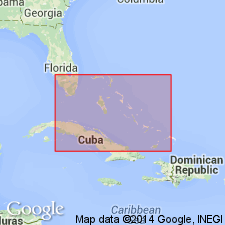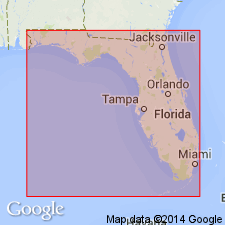
- Usage in publication:
-
- Pine Key Formation
- Modifications:
-
- Named
- Dominant lithology:
-
- Limestone
- AAPG geologic province:
-
- South Florida province
Summary:
Named for Big Pine Key, FL. Formerly called Late Cretaceous chalk. Type locality is Gulf Oil Corp. State of Florida-1, Lease 373, Big Pine Key, sec. 2, T67S, R29E, Monroe Co., FL, known as the Big Pine Key well. Consists of alternate soft and hard, white to cream-white limestone and chalky limestone containing many porous zones and a predominantly pelagic microfauna. Contains marlstone in places. Well-developed on Jordan Knoll. Unconformably underlies Cedar Keys Formation; unconformably overlies the Naples Bay Group of the Marquesas Supergroup. Report includes correlation chart. Age is Late Cretaceous (late Cenomanian through Maastrichtian).
Source: GNU records (USGS DDS-6; Reston GNULEX).

- Usage in publication:
-
- Pine Key Formation*
- Modifications:
-
- Overview
- AAPG geologic province:
-
- South Florida province
Summary:
Shown in the subsurface of the eastern Gulf Coastal Plain. Age is Late Cretaceous.
Source: GNU records (USGS DDS-6; Reston GNULEX).
For more information, please contact Nancy Stamm, Geologic Names Committee Secretary.
Asterisk (*) indicates published by U.S. Geological Survey authors.
"No current usage" (†) implies that a name has been abandoned or has fallen into disuse. Former usage and, if known, replacement name given in parentheses ( ).
Slash (/) indicates name conflicts with nomenclatural guidelines (CSN, 1933; ACSN, 1961, 1970; NACSN, 1983, 2005, 2021). May be explained within brackets ([ ]).

